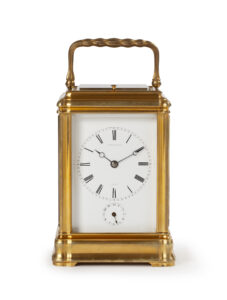STRUT CLOCK WITH TRAVELLING CASE THOs. Cole London No: 813 Ca. 1850 England
M&R104
STRUT CLOCK IN THE SHAPE OF A LUTE WITH TRAVELLING CASE
Signed: THOs. Cole London
Numbered: 813
Circa 1850
England
Movement
The spring-driven circular, gilt brass movement has a going train only. It has a vertical lever escapement and adjustable hairspring balance.
Dial
The circular silvered dial has Roman hour numerals, five-minute and minute divisions. The dial is fully engraved in floral and scroll leaf motifs. The time is indicated by a pair of blued steel hands. The dial is protected by a bevelled glass.
Case
The gilt brass case is shaped in the form of a lute and is decorated on the front and back with engravings in a floral and scroll leaf motifs. In the neck of the instrument is a thermometer. The movement has a winding arbor on the back. Above this is the square, indicated by ‘hands’, with which the hands can be set. A small ‘slow/fast’ slide is fitted next to the hands square. When this slide is opened, a pin becomes visible with which the movement can be adjusted. The clock rests on a moulded foot and at the back there is an easel type support with which the clock can be placed at an angle (the strut). The foot is signed Thos. Cole London 813.
Travelling case
The original moulded wooden case, which protects the clock when it is transported, has a green velvet and cream silk lining and is covered on the outside with dark green leather with a gold decorative line ornamentation. The original winding key can be stored in a recess in the case. It can be opened from the side.
Literature
Many strut clocks are depicted in: Derek Roberts, Carriage and Other Traveling Clocks, p. 278, fig. 8-15.
Duration: 1 week
Height 17 cm.
Width 7 cm.
Depth 4.5 cm. (including base)
Literature
– B. Loomes, Watchmakers & Clockmakers of the World, (2006), p. 164.
-J.B. Hawkins, Thomas Cole & Victorian Clockmaking, pp. 12 ff.
The maker
Thomas Cole was born in Nether Stowey, Somerset, in 1800. He was baptized there on March 17. His father, James Cole, was probably also a clockmaker and was married to Catherine Slocombe. Thomas Cole, the youngest in the family, was the brother of the famous clockmaker James Ferguson Cole. In 1813 the family left Nether Stowey and it is not known where they moved. James Ferguson settled in London as a clockmaker in 1821, two years later Thomas also came to London. From 1829 the brothers worked together on New Bond Street. After a few years they broke up again. Thomas Cole does not appear again in the books until 1838 when he is listed as a watchmaker at no. 10 Upper King Street, Bloomsbury. Thomas’ first wife died. He remarried Charlotte Boulding on October 28, 1841. Charlotte was then 21 years old. Their first child, Thomas William, was born on August 13, 1842. After this, the couple had another son and two daughters. From 1851 or 1852 Thomas Cole settled in his last workshop, at no.6 Castle Street, Holborn. He was elected to the Royal Society of Arts on 28 June 1861 but does not appear to have accepted it. He became a member of the British Horological Institute where his brother held an important position. Thomas Cole died on January 3, 1864












